| ID |
Date |
Author |
Subject |
|
177
|
Wed Aug 29 16:42:42 2012 |
Zach Miller | DRS-4.0.0 DOScreen.cpp |
| Stefan Ritt wrote: |
|
| Zach Miller wrote: |
|
Hi,
I found an old thread regarding a fix for DOScreen.cpp for DRS-3.1.0, that fixes an "ambiguous overload problem." Currently when I attempt to build the drs-4.0.0, I get this similar error:
src/DOScreen.cpp:332:39: error: call of overloaded ‘Append(int)’ is ambiguous
This section of code is different than what the previous thread was correcting, and though I attempted to apply the logic of the old thread, I haven't fixed this yet.
The following is the code for that section:
-----
329 for (int i=0 ; i<5 ; i++)
330 if (tc & (1<<(i+8))) {
331 if (i < 4)
332 wxst1.Append(wxT('1'+i));
333 else
334 wxst1.Append(wxT('E'));
335 wxst1.Append(wxT('&'));
336 }
337 if (wxst1.Length() > 0)
338 wxst1 = wxst1.Left(wxst1.Length()-1);
339 wxst1.Append(wxT(')'));
------
I've attempted a few fixes, but unfortunately, my understanding of the code is not great, and I haven't managed to fix this yet. Any help would be appreciated.
Thanks,
Zach Miller
|
Just put (char) in front of wxT(...), like
if (tc > 0) {
wxString wxst1, wxst2;
wxst1.Append((char)wxT('('));
for (int i=0 ; i<5 ; i++)
if (tc & (1<<i)) {
if (i < 4)
wxst1.Append((char) (wxT('1'+i)));
else
wxst1.Append((char) wxT('E'));
wxst1.Append((char) wxT('|'));
}
for (int i=0 ; i<5 ; i++)
if (tc & (1<<(i+8))) {
if (i < 4)
wxst1.Append((char) (wxT('1'+i)));
else
wxst1.Append((char) wxT('E'));
wxst1.Append((char) wxT('&'));
}
if (wxst1.Length() > 0)
wxst1 = wxst1.Left(wxst1.Length()-1);
wxst1.Append((char) wxT(')'));
|
Hi Stefan,
Thanks for the response. I have tried that and it fixes all the lines except the ones that have:
wxst1.Append((char) (wxT('1'+i)));
Those lines still don't compile for me. I've also tried: wxst1.Append((char) (wxT('1'+(char)i))); and wxst1.Append((char) (wxT((char)'1'+i))); as well as a few other combinations of (char) and Append.
I get the same error of: "Call of overloaded "Append(int)" is ambiguous."
Any other help would be greatly appreciated. Thanks!
-Zach |
|
178
|
Wed Aug 29 16:45:36 2012 |
Stefan Ritt | DRS-4.0.0 DOScreen.cpp |
| Zach Miller wrote: |
|
| Stefan Ritt wrote: |
|
| Zach Miller wrote: |
|
Hi,
I found an old thread regarding a fix for DOScreen.cpp for DRS-3.1.0, that fixes an "ambiguous overload problem." Currently when I attempt to build the drs-4.0.0, I get this similar error:
src/DOScreen.cpp:332:39: error: call of overloaded ‘Append(int)’ is ambiguous
This section of code is different than what the previous thread was correcting, and though I attempted to apply the logic of the old thread, I haven't fixed this yet.
The following is the code for that section:
-----
329 for (int i=0 ; i<5 ; i++)
330 if (tc & (1<<(i+8))) {
331 if (i < 4)
332 wxst1.Append(wxT('1'+i));
333 else
334 wxst1.Append(wxT('E'));
335 wxst1.Append(wxT('&'));
336 }
337 if (wxst1.Length() > 0)
338 wxst1 = wxst1.Left(wxst1.Length()-1);
339 wxst1.Append(wxT(')'));
------
I've attempted a few fixes, but unfortunately, my understanding of the code is not great, and I haven't managed to fix this yet. Any help would be appreciated.
Thanks,
Zach Miller
|
Just put (char) in front of wxT(...), like
if (tc > 0) {
wxString wxst1, wxst2;
wxst1.Append((char)wxT('('));
for (int i=0 ; i<5 ; i++)
if (tc & (1<<i)) {
if (i < 4)
wxst1.Append((char) (wxT('1'+i)));
else
wxst1.Append((char) wxT('E'));
wxst1.Append((char) wxT('|'));
}
for (int i=0 ; i<5 ; i++)
if (tc & (1<<(i+8))) {
if (i < 4)
wxst1.Append((char) (wxT('1'+i)));
else
wxst1.Append((char) wxT('E'));
wxst1.Append((char) wxT('&'));
}
if (wxst1.Length() > 0)
wxst1 = wxst1.Left(wxst1.Length()-1);
wxst1.Append((char) wxT(')'));
|
Hi Stefan,
Thanks for the response. I have tried that and it fixes all the lines except the ones that have:
wxst1.Append((char) (wxT('1'+i)));
Those lines still don't compile for me. I've also tried: wxst1.Append((char) (wxT('1'+(char)i))); and wxst1.Append((char) (wxT((char)'1'+i))); as well as a few other combinations of (char) and Append.
I get the same error of: "Call of overloaded "Append(int)" is ambiguous."
Any other help would be greatly appreciated. Thanks!
-Zach
|
wxst1.Append((char) (wxT((char)('1'+i)))); maybe ??? |
|
179
|
Wed Aug 29 16:57:49 2012 |
Zach Miller | DRS-4.0.0 DOScreen.cpp |
| Stefan Ritt wrote: |
|
| Zach Miller wrote: |
|
| Stefan Ritt wrote: |
|
| Zach Miller wrote: |
|
Hi,
I found an old thread regarding a fix for DOScreen.cpp for DRS-3.1.0, that fixes an "ambiguous overload problem." Currently when I attempt to build the drs-4.0.0, I get this similar error:
src/DOScreen.cpp:332:39: error: call of overloaded ‘Append(int)’ is ambiguous
This section of code is different than what the previous thread was correcting, and though I attempted to apply the logic of the old thread, I haven't fixed this yet.
The following is the code for that section:
-----
329 for (int i=0 ; i<5 ; i++)
330 if (tc & (1<<(i+8))) {
331 if (i < 4)
332 wxst1.Append(wxT('1'+i));
333 else
334 wxst1.Append(wxT('E'));
335 wxst1.Append(wxT('&'));
336 }
337 if (wxst1.Length() > 0)
338 wxst1 = wxst1.Left(wxst1.Length()-1);
339 wxst1.Append(wxT(')'));
------
I've attempted a few fixes, but unfortunately, my understanding of the code is not great, and I haven't managed to fix this yet. Any help would be appreciated.
Thanks,
Zach Miller
|
Just put (char) in front of wxT(...), like
if (tc > 0) {
wxString wxst1, wxst2;
wxst1.Append((char)wxT('('));
for (int i=0 ; i<5 ; i++)
if (tc & (1<<i)) {
if (i < 4)
wxst1.Append((char) (wxT('1'+i)));
else
wxst1.Append((char) wxT('E'));
wxst1.Append((char) wxT('|'));
}
for (int i=0 ; i<5 ; i++)
if (tc & (1<<(i+8))) {
if (i < 4)
wxst1.Append((char) (wxT('1'+i)));
else
wxst1.Append((char) wxT('E'));
wxst1.Append((char) wxT('&'));
}
if (wxst1.Length() > 0)
wxst1 = wxst1.Left(wxst1.Length()-1);
wxst1.Append((char) wxT(')'));
|
Hi Stefan,
Thanks for the response. I have tried that and it fixes all the lines except the ones that have:
wxst1.Append((char) (wxT('1'+i)));
Those lines still don't compile for me. I've also tried: wxst1.Append((char) (wxT('1'+(char)i))); and wxst1.Append((char) (wxT((char)'1'+i))); as well as a few other combinations of (char) and Append.
I get the same error of: "Call of overloaded "Append(int)" is ambiguous."
Any other help would be greatly appreciated. Thanks!
-Zach
|
wxst1.Append((char) (wxT((char)('1'+i)))); maybe ???
|
Aha!
wxst1.Append((char) (wxT('1'+i)));
That one actually works as you initially thought, but you my editor was being picky of (char)wxt... instead of (char) (wxt....). For some reason, it has to have the extra set of parentheses around wxt(). Thank You! |
|
443
|
Fri Aug 7 18:41:37 2015 |
dante | DRS4 | Hi
I have just installed DRS4, but when I try to view it from the USB it don't work. Why?
[ .../home $] lsusb -d 04b4:1175 -v
Bus 002 Device 008: ID 04b4:1175 Cypress Semiconductor Corp.
Couldn't open device, some information will be missing
Device Descriptor: |
|
444
|
Fri Aug 7 20:32:15 2015 |
Felix Bachmair | DRS4 | Hi
Did you copy the udev rule 41-drs.rules into /etc/udev/rules.d/ ?
Which operating system are you using?
Cheers
Felix
| dante wrote: |
|
Hi
I have just installed DRS4, but when I try to view it from the USB it don't work. Why?
[ .../home $] lsusb -d 04b4:1175 -v
Bus 002 Device 008: ID 04b4:1175 Cypress Semiconductor Corp.
Couldn't open device, some information will be missing
Device Descriptor:
|
|
|
771
|
Tue Aug 27 08:33:22 2019 |
chinmay basu | DRS4 | Is DRS4 suitable for use with Silicon surface barrier detectors? |
|
772
|
Tue Aug 27 09:14:03 2019 |
Stefan Ritt | DRS4 | Is a 5 GSPS oscilloscope suitable for use with Silicon surface barier detectors?
| chinmay basu wrote: |
|
Is DRS4 suitable for use with Silicon surface barrier detectors?
|
|
|
145
|
Thu Jan 26 09:12:03 2012 |
Ravindra Raghunath Shinde | DRS4 Rev2.0 for analog pulse counting | Hello,
We are using DRS4 Rev.2.0 board.
We want to measure number of pulses generated by charge particle detector. These negative going analog pulses are very fast having rise time about 2nS.
We want keep threshold level to -20mV. We expected pulse rate to be about 100 to 200 Hz.
I need help to implement this in current DRS board with dead time free operation.
|
|
146
|
Thu Jan 26 09:15:42 2012 |
Stefan Ritt | DRS4 Rev2.0 for analog pulse counting |
| Ravindra Raghunath Shinde wrote: |
|
Hello,
We are using DRS4 Rev.2.0 board.
We want to measure number of pulses generated by charge particle detector. These negative going analog pulses are very fast having rise time about 2nS.
We want keep threshold level to -20mV. We expected pulse rate to be about 100 to 200 Hz.
I need help to implement this in current DRS board with dead time free operation.
|
If you just want to count pulses, you do not need a DRS board. Just use a discriminator and a counter, that's much simpler. The DRS board is not dead time free. |
|
147
|
Thu Jan 26 09:44:34 2012 |
Ravindra Raghunath Shinde | DRS4 Rev2.0 for analog pulse counting |
| Stefan Ritt wrote: |
|
| Ravindra Raghunath Shinde wrote: |
|
Hello,
We are using DRS4 Rev.2.0 board.
We want to measure number of pulses generated by charge particle detector. These negative going analog pulses are very fast having rise time about 2nS.
We want keep threshold level to -20mV. We expected pulse rate to be about 100 to 200 Hz.
I need help to implement this in current DRS board with dead time free operation.
|
If you just want to count pulses, you do not need a DRS board. Just use a discriminator and a counter, that's much simpler. The DRS board is not dead time free.
|
Thanks for your prompt reply.
Along with pulse rate we also want see pulse shape as well as charge measurements. That is why we are exploring this option with our existing DRS Set-up.
|
|
148
|
Thu Jan 26 09:49:38 2012 |
Stefan Ritt | DRS4 Rev2.0 for analog pulse counting |
| Ravindra Raghunath Shinde wrote: |
|
| Stefan Ritt wrote: |
|
| Ravindra Raghunath Shinde wrote: |
|
Hello,
We are using DRS4 Rev.2.0 board.
We want to measure number of pulses generated by charge particle detector. These negative going analog pulses are very fast having rise time about 2nS.
We want keep threshold level to -20mV. We expected pulse rate to be about 100 to 200 Hz.
I need help to implement this in current DRS board with dead time free operation.
|
If you just want to count pulses, you do not need a DRS board. Just use a discriminator and a counter, that's much simpler. The DRS board is not dead time free.
|
Thanks for your prompt reply.
Along with pulse rate we also want see pulse shape as well as charge measurements. That is why we are exploring this option with our existing DRS Set-up.
|
I understand that. But still the board has some dead time which is dominated by the USB data transfer speed.
There is a way to perform the counting dead time free, but that requires the V4 board, which has a hardware comparator on all four channels (The V2 board has only one comparator and a multiplexer). The output of these comparators go directly to the FPGA, which can then trigger on these signals. In principle one could implement a hardware counter in the FPGA, which works practically dead time free. But this requires a new firmware which has to be written. Either you do it yourself using the Xilinx development tools, or you wait until I find some time to implement this, which could take a couple of weeks or even months.
Best regards,
Stefan |
|
149
|
Thu Jan 26 10:05:57 2012 |
Ravindra Raghunath Shinde | DRS4 Rev2.0 for analog pulse counting |
| Stefan Ritt wrote: |
|
| Ravindra Raghunath Shinde wrote: |
|
| Stefan Ritt wrote: |
|
| Ravindra Raghunath Shinde wrote: |
|
Hello,
We are using DRS4 Rev.2.0 board.
We want to measure number of pulses generated by charge particle detector. These negative going analog pulses are very fast having rise time about 2nS.
We want keep threshold level to -20mV. We expected pulse rate to be about 100 to 200 Hz.
I need help to implement this in current DRS board with dead time free operation.
|
If you just want to count pulses, you do not need a DRS board. Just use a discriminator and a counter, that's much simpler. The DRS board is not dead time free.
|
Thanks for your prompt reply.
Along with pulse rate we also want see pulse shape as well as charge measurements. That is why we are exploring this option with our existing DRS Set-up.
|
I understand that. But still the board has some dead time which is dominated by the USB data transfer speed.
There is a way to perform the counting dead time free, but that requires the V4 board, which has a hardware comparator on all four channels (The V2 board has only one comparator and a multiplexer). The output of these comparators go directly to the FPGA, which can then trigger on these signals. In principle one could implement a hardware counter in the FPGA, which works practically dead time free. But this requires a new firmware which has to be written. Either you do it yourself using the Xilinx development tools, or you wait until I find some time to implement this, which could take a couple of weeks or even months.
Best regards,
Stefan
|
Thank you very much.
With regards,
Ravindra R. Shinde |
|
659
|
Tue Feb 27 16:34:26 2018 |
Steven Block | DRS4 Dead times | Hello All,
I am currently trying to figure out how to properly characterize the dead time of the DRS4 board. My most recent experiment to try and answer this question involved using an external trigger that can range from 1Hz to 2MHz. I fed this trigger into the DRS4 and collected 1000 samples with no input to any channels. I repeated this across the range of my external trigger by a factor of ten [10Hz, 100Hz, 1kHz...etc]. After I had saved these runs in XML format, I looked at the difference between timestamps on the events. Attached are my findings. Can someone offer an explanation for the periodic peaks? I am new to the DRS4 and don't really understand how it works. My guess is that there is a buffer that has to be emptied every so often, but if so, the buffer emptying time varies with the frequency of the trigger. I would ideally like to be able to know the relation of the dead time to a particular setting I change on the DRS4 such as locking the sampling speed or changing external trigger frequency.
Best,
Steven |
| Attachment 1: 1kHz.png
|
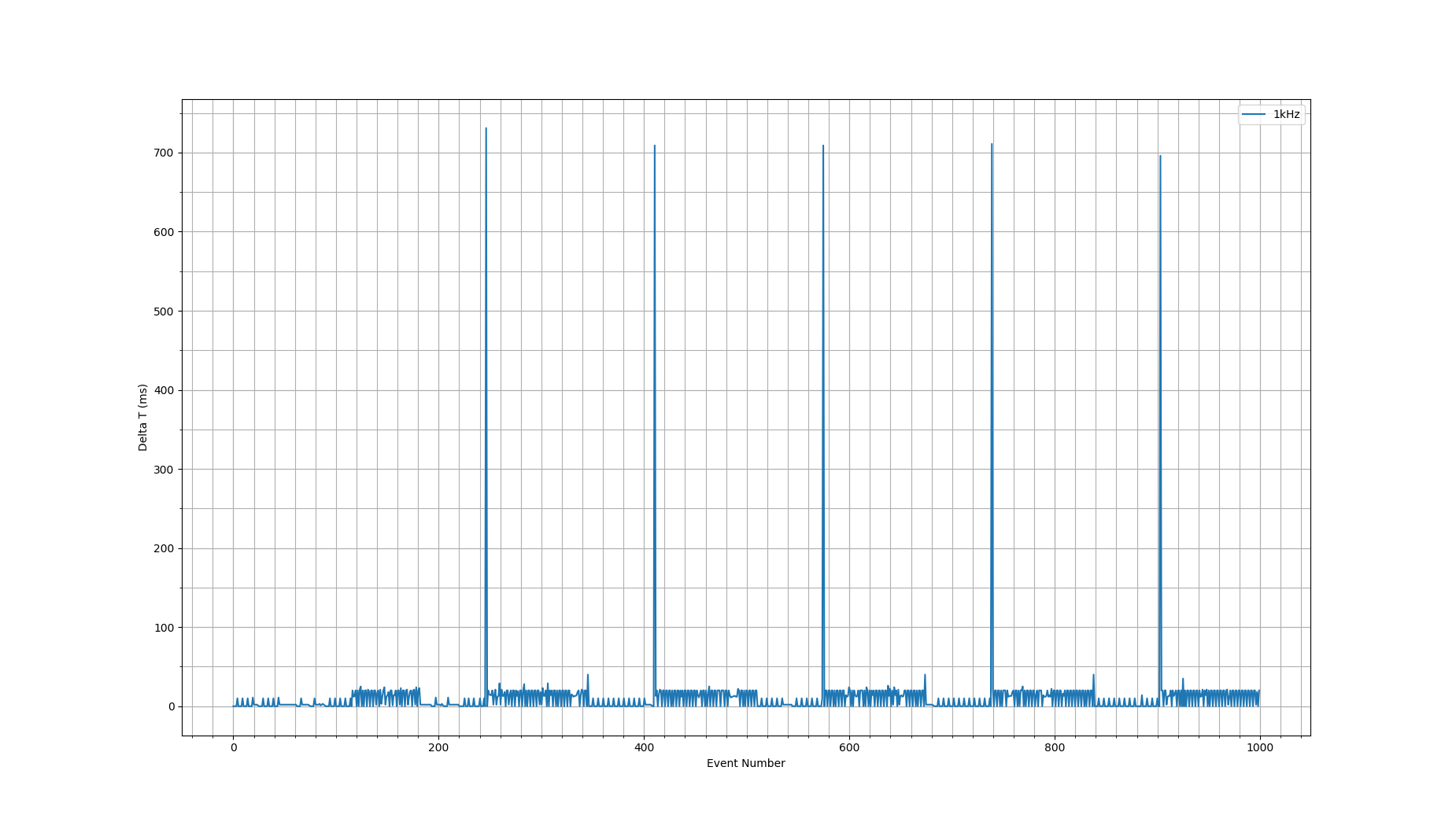
|
| Attachment 2: 1MHz.png
|
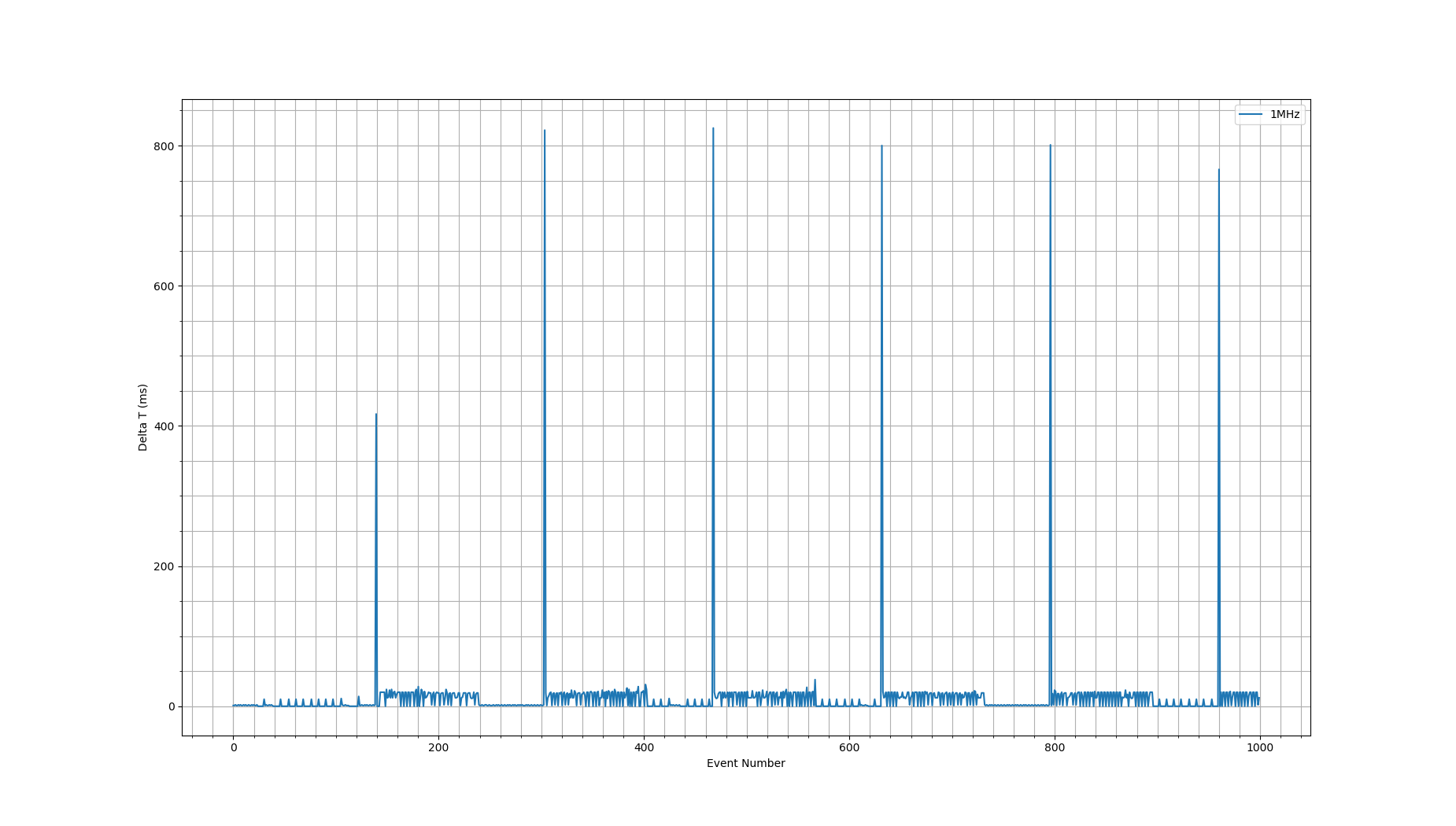
|
| Attachment 3: 10Hz.png
|
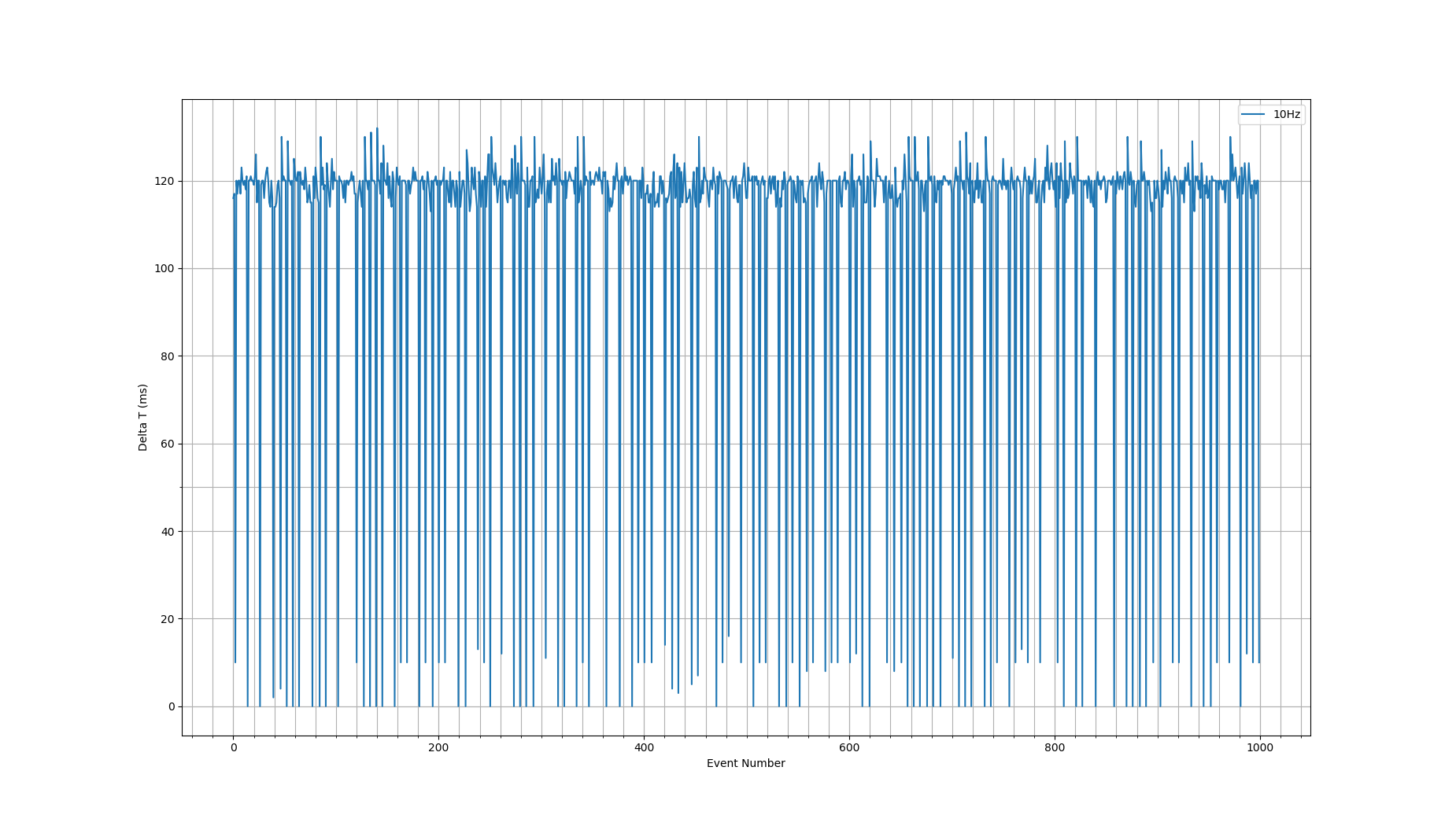
|
| Attachment 4: 10kHz.png
|
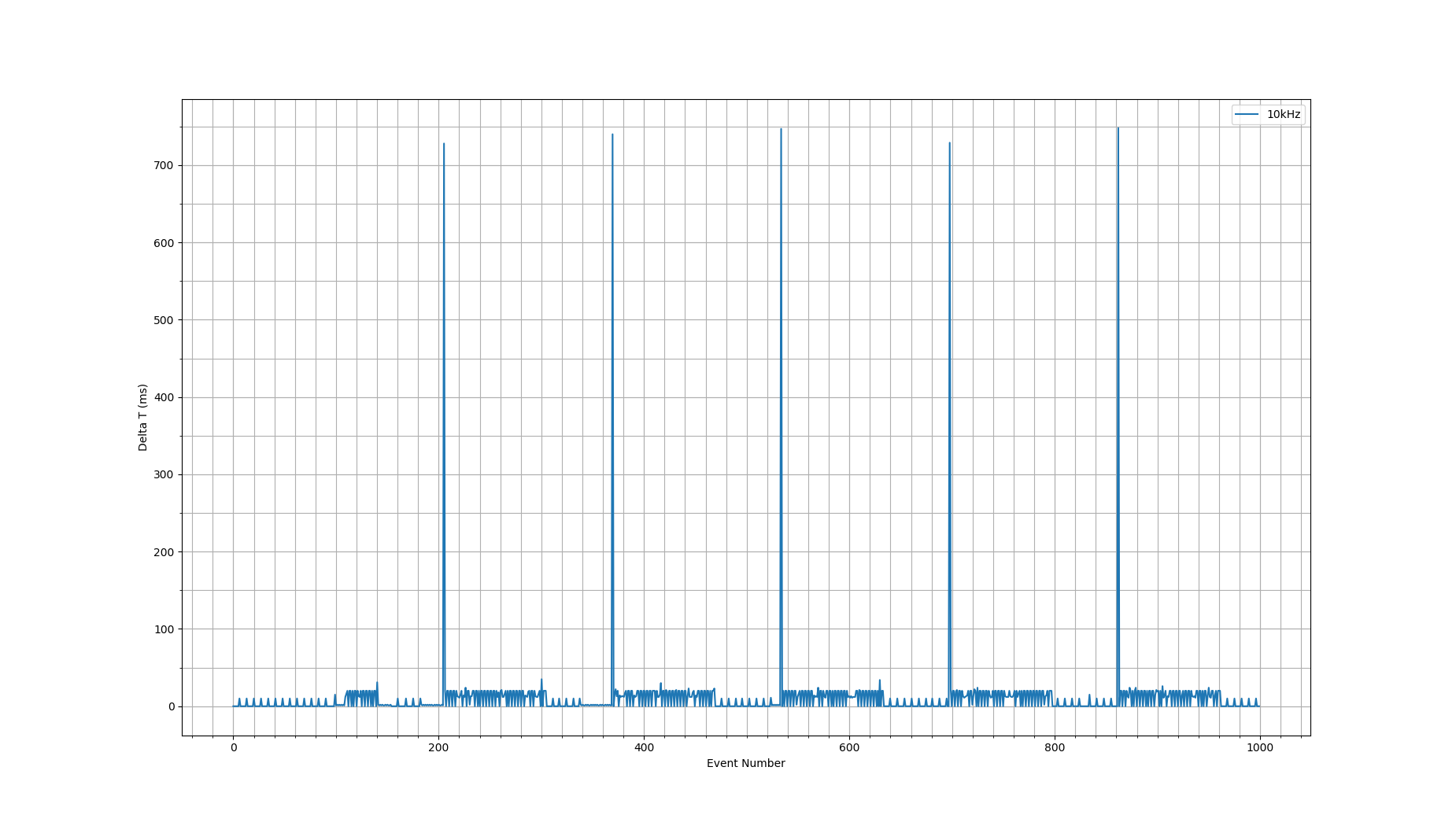
|
| Attachment 5: 100Hz.png
|
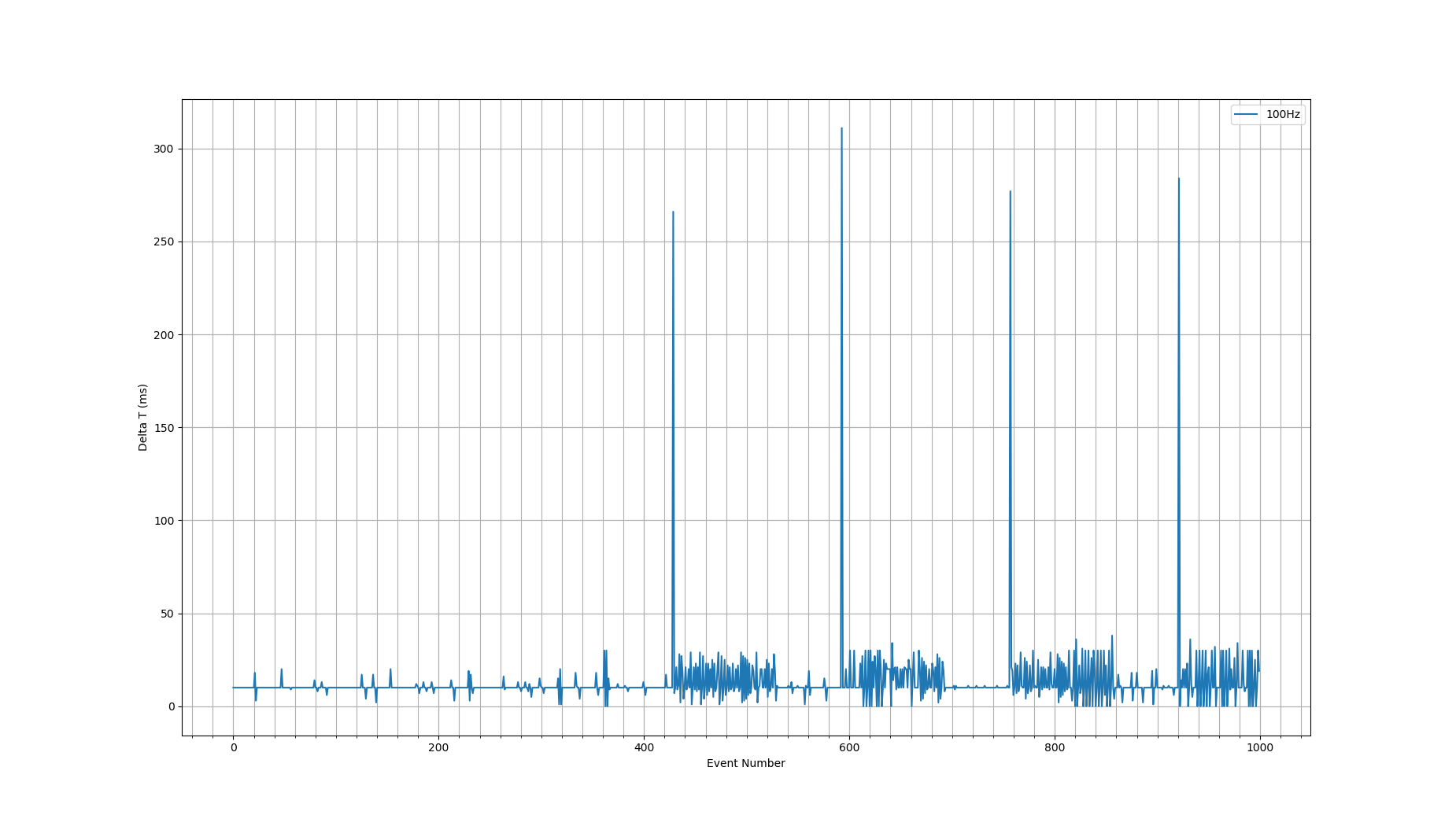
|
| Attachment 6: 100kHz.png
|
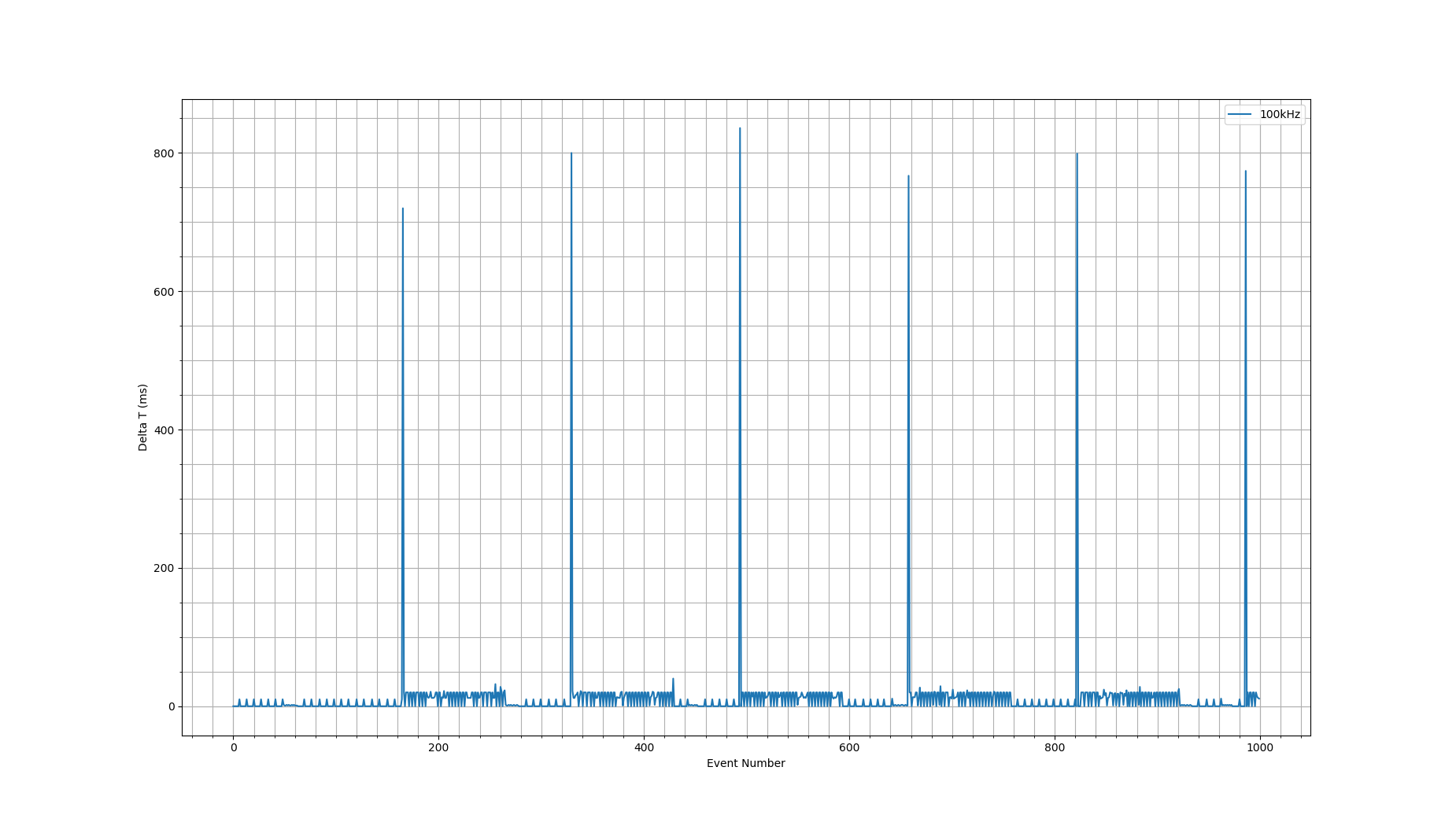
|
|
660
|
Tue Feb 27 17:04:12 2018 |
Stefan Ritt | DRS4 Dead times | XML is very slow to write, and you are probably limited by that. Switch to binary mode, which is much faster. You will see in the end a maximum rate of ~500 Hz, and thus a dead time of 2ms, independent of the sampling speed. Note that you have only an evaluation board, which is optimized for ease of use. If you develop your own electronics, and do optimized readout, you can bring the deadtime down to 30ns x number of samples + 2us, or 32us if you read 1024 values from one channel.
Stefan
| Steven Block wrote: |
|
Hello All,
I am currently trying to figure out how to properly characterize the dead time of the DRS4 board. My most recent experiment to try and answer this question involved using an external trigger that can range from 1Hz to 2MHz. I fed this trigger into the DRS4 and collected 1000 samples with no input to any channels. I repeated this across the range of my external trigger by a factor of ten [10Hz, 100Hz, 1kHz...etc]. After I had saved these runs in XML format, I looked at the difference between timestamps on the events. Attached are my findings. Can someone offer an explanation for the periodic peaks? I am new to the DRS4 and don't really understand how it works. My guess is that there is a buffer that has to be emptied every so often, but if so, the buffer emptying time varies with the frequency of the trigger. I would ideally like to be able to know the relation of the dead time to a particular setting I change on the DRS4 such as locking the sampling speed or changing external trigger frequency.
Best,
Steven
|
|
|
661
|
Tue Feb 27 18:04:18 2018 |
Steven Block | DRS4 Dead times | That is extremely helpful! Many thanks. One more question; If I were to take inputs from 2 channels at once, would that scale the dead time to 64us using your example?
Steven
| Stefan Ritt wrote: |
|
XML is very slow to write, and you are probably limited by that. Switch to binary mode, which is much faster. You will see in the end a maximum rate of ~500 Hz, and thus a dead time of 2ms, independent of the sampling speed. Note that you have only an evaluation board, which is optimized for ease of use. If you develop your own electronics, and do optimized readout, you can bring the deadtime down to 30ns x number of samples + 2us, or 32us if you read 1024 values from one channel.
Stefan
| Steven Block wrote: |
|
Hello All,
I am currently trying to figure out how to properly characterize the dead time of the DRS4 board. My most recent experiment to try and answer this question involved using an external trigger that can range from 1Hz to 2MHz. I fed this trigger into the DRS4 and collected 1000 samples with no input to any channels. I repeated this across the range of my external trigger by a factor of ten [10Hz, 100Hz, 1kHz...etc]. After I had saved these runs in XML format, I looked at the difference between timestamps on the events. Attached are my findings. Can someone offer an explanation for the periodic peaks? I am new to the DRS4 and don't really understand how it works. My guess is that there is a buffer that has to be emptied every so often, but if so, the buffer emptying time varies with the frequency of the trigger. I would ideally like to be able to know the relation of the dead time to a particular setting I change on the DRS4 such as locking the sampling speed or changing external trigger frequency.
Best,
Steven
|
|
|
|
662
|
Tue Feb 27 18:12:32 2018 |
Stefan Ritt | DRS4 Dead times | For applications which are critical on the dead time, one typically uses one ADC per DRS4 channel, and thus the dead time stays at 32us. If you multiplex two DRS4 channels into one ADC channel, then it goes to 32us.
Stefan
| Steven Block wrote: |
|
That is extremely helpful! Many thanks. One more question; If I were to take inputs from 2 channels at once, would that scale the dead time to 64us using your example?
Steven
| Stefan Ritt wrote: |
|
XML is very slow to write, and you are probably limited by that. Switch to binary mode, which is much faster. You will see in the end a maximum rate of ~500 Hz, and thus a dead time of 2ms, independent of the sampling speed. Note that you have only an evaluation board, which is optimized for ease of use. If you develop your own electronics, and do optimized readout, you can bring the deadtime down to 30ns x number of samples + 2us, or 32us if you read 1024 values from one channel.
Stefan
| Steven Block wrote: |
|
Hello All,
I am currently trying to figure out how to properly characterize the dead time of the DRS4 board. My most recent experiment to try and answer this question involved using an external trigger that can range from 1Hz to 2MHz. I fed this trigger into the DRS4 and collected 1000 samples with no input to any channels. I repeated this across the range of my external trigger by a factor of ten [10Hz, 100Hz, 1kHz...etc]. After I had saved these runs in XML format, I looked at the difference between timestamps on the events. Attached are my findings. Can someone offer an explanation for the periodic peaks? I am new to the DRS4 and don't really understand how it works. My guess is that there is a buffer that has to be emptied every so often, but if so, the buffer emptying time varies with the frequency of the trigger. I would ideally like to be able to know the relation of the dead time to a particular setting I change on the DRS4 such as locking the sampling speed or changing external trigger frequency.
Best,
Steven
|
|
|
|
|
334
|
Thu Apr 10 14:45:12 2014 |
Roman Gredig | DRS4 Evalboard V5 with Windows7Pro64bit |
Dear Stefan
I am trying to use the DRS4 eval board on a Windows7 machine. Unfortunately I get an error message saying "No DRS
board found". But I can see the DRS board in the device manager with the proper driver loaded. Is there any known
problem with win7?
I am using windows7 professional (SP1) with the drs software 5.0.1.
Cheers,
Roman
PS: Everything is working on my mac. But not under windows7. |
|
339
|
Wed Apr 16 10:24:55 2014 |
Stefan Ritt | DRS4 Evalboard V5 with Windows7Pro64bit | >
> Dear Stefan
>
> I am trying to use the DRS4 eval board on a Windows7 machine. Unfortunately I get an error message saying "No DRS
> board found". But I can see the DRS board in the device manager with the proper driver loaded. Is there any known
> problem with win7?
>
> I am using windows7 professional (SP1) with the drs software 5.0.1.
>
> Cheers,
> Roman
>
> PS: Everything is working on my mac. But not under windows7.
Hi Roman,
please read section 2.3. (page 13) from the Evaluation Board manual: http://www.psi.ch/drs/DocumentationEN/manual_rev50.pdf
You have to update the USB driver in your Computer Management.
Cheers,
Stefan |
|
401
|
Sun Apr 5 22:16:48 2015 |
Julien Wulf | DRS4 Evaluation Board Baseline/Voltage Calibration | Hi,
I`m trying to calibrate my DRS4 evoluation board to an input range of 0-1V but it doesn`t work.
1) First I tried to calibrate it with the drsosc (version 5.0.3) Software. The -0.5V - 0.5V calibration works, but during the 0 - 1V calibration the Software crashes.
2) I also tried to calibrate the input range with a C++ DAQ Package (based on drs_exam). Here the code of the calibration:
....
b->SetInputRange(0.) (Center at 0 V )
b->CalibrateVolt(NULL);
....
Calibration Works
....
b->SetInputRange(0.5) (Center at 0.5 V )
b->CalibrateVolt(NULL);
....
Results in: Found 4096 stuck pixels on this board.
Did I do a mistake or is this a normal behaviour of the board? Also the board often crashes and I get a magic number 0000 after restarting the DAQ. Then the board needs to be restarted via pulling the plug. ( I ensured that I terminate the USB connection before I close the program with "delete drs"). Is there a possibility to avoid this error?
My OS: Ubuntu 14.04 LTS.
Ciao,
Julien |
|
406
|
Tue Apr 21 12:52:18 2015 |
Stefan Ritt | DRS4 Evaluation Board Baseline/Voltage Calibration | 1) I tried to cablirate a V5 board with drsosc 5.0.3 and it just worked fine for me. No idea what went wrong in your case.
2) The "found 4096 stuck pixels on this board" can be safely ignored. It comes from the fact that the standard evaluation board has four cannels unconnected (the DRS4 chip has 8 channels, four are connected to in the evaluation board and four are unconnected). So the software sees wrong values on four channels because they are unconnected and thinks something is wrong. Unfortunately the software cannot determine if the channels are connected or not. So just ignore it.
3) I heard several people having to reset their boards under Linux in a similar way than you. This is probalby due to some instability in the USB part of the linux kernel, since the problem does not occur on other systems (Windows, Mac OSX). So I cannot do anything from the software side.
/Stefan
| Julien Wulf wrote: |
|
Hi,
I`m trying to calibrate my DRS4 evoluation board to an input range of 0-1V but it doesn`t work.
1) First I tried to calibrate it with the drsosc (version 5.0.3) Software. The -0.5V - 0.5V calibration works, but during the 0 - 1V calibration the Software crashes.
2) I also tried to calibrate the input range with a C++ DAQ Package (based on drs_exam). Here the code of the calibration:
....
b->SetInputRange(0.) (Center at 0 V )
b->CalibrateVolt(NULL);
....
Calibration Works
....
b->SetInputRange(0.5) (Center at 0.5 V )
b->CalibrateVolt(NULL);
....
Results in: Found 4096 stuck pixels on this board.
Did I do a mistake or is this a normal behaviour of the board? Also the board often crashes and I get a magic number 0000 after restarting the DAQ. Then the board needs to be restarted via pulling the plug. ( I ensured that I terminate the USB connection before I close the program with "delete drs"). Is there a possibility to avoid this error?
My OS: Ubuntu 14.04 LTS.
Ciao,
Julien
|
|
|